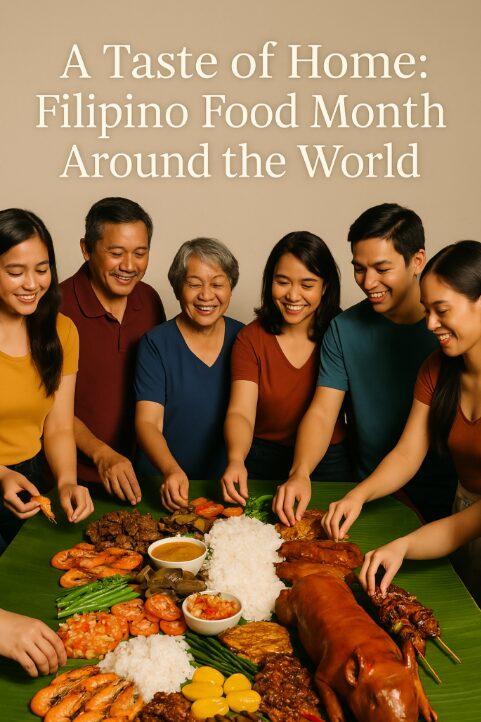After a long and arduous journey, Tsismis NYC finally opened its doors last month to hordes of hungry diners. We went on their third week and noticed that the hostess turned away at least five parties wanting to eat because the restaurant was running full house that evening.

“We’re all about promoting food and culture here in New York City,” remarked executive chef Jappy Afzelius, who started this concept with the owners Stephen Young and Reggie Aguinaldo.
The name Tsismis or chismis comes from the Spanish word chisme, which means to gossip. As in every Filipino meal, tsismis is that extra spice that makes the gathering over good food and drinks a more fun experience. Whether it’s about catching up on each others’ activities or about politics and showbiz here and back home, we’re all about the latest cheese, tsismis that is.
With only a little more than a month since their opening last June, Jappy already has his share of the usual restaurant problems and challenges, from staffing issues to undelivered ingredients and broken plates and glasses.
He has also received complaints from some well-meaning, yet critical guests.
As we already all know, Filipinos are among the most (hard to please and) stringent critics of Filipino cuisine.
“Ang daming comments, from ‘This is not traditional’ to ‘This is not how my Lola cooked this’ or ‘I grew up eating something different’. I always tell them, we are a restaurant so we should be not exactly similar to home cooking because why then would you come to us when you can have it at home,” Jappy explained.
“It has to be a little bit different. Not better because there is nothing better than your mother’s or grandmother’s cooking. We don’t aspire to compete with that. We just want to showcase what we have created and have a place for you to come and hang out,” he added.

Happy Hour: Five Thirsty
Aside from pushing Filipino cuisine, Jappy and his team wanted to revive “Five Thirsty,” a happy hour concept made famous in the Philippines back in the 90s.
Jappy trained in Paris under famed chef Alain Ducasse at Chez Allard Bistro and he used to hangout with fellow Filipinos and they would go to French bistros, eat, drink and gossip about the kitchen life, what was going on in the food scene in the Philippines, what Filipino chefs were doing in America and what their dreams were.
It dawned on him that during his college days back in the Philippines, people used to love to go out, eat and talk. He wanted to share that side of Filipino culture where family and friends would have a good time, share a good meal and have some drinks, whether it is wine or San Miguel Beer.
The idea of opening a casual, French style bistro serving Filipino cuisine in New York has been percolating in Jappy’s mind since then. Lucky for him, he says, he met the right team and made the project grow and flourish. It took a little while, and now Tsismis is fast becoming a favorite hangout of Filipinos in the area.
“So far, the neighborhood of the Lower East Side has been very welcoming,” Jappy said. “They love the concept, the food and they’re starting to love Filipino culture as well.”
Misconceptions
As a chef, Jappy feels that Filipino cuisine is so far behind our Asian neighbors like Thailand and Vietnam but with the current influx of chefs in Europe and America, he believes that the cuisine has started to get the recognition it truly deserves.
The misconceptions do not help at all: that Filipino dishes are too oily, everything is deep fried, everything is rice heavy.
“Vegetables are predominant in our cuisine. We just need to use them more because we’re brainwashed into thinking that Filipino cuisine is all about sisig, liempo, lechon, bagnet and inasal that we tend to forget, masarap din ang pinakbet, or pinapaitan salad or salted egg salad,” he said. “These dishes can shine, we just have to put them on the center and allow them to shine.”
After his training in Paris, he was sent to New York to work at Benoit, another Ducasse restaurant. He also worked in David Burke’s Fabrick and then eventually at Manila Social Club in Brooklyn where he honed his skills in Filipino cuisine, using the French techniques he has learned along the way.
After his stint at Manila Social Club, he had the opportunity to travel to Italy and Japan where he did pop ups to promote Filipino cuisine and upon his return to New York, focused on opening Tsismis.
“We’re not traditional, we’re not modern. We’re kinda in between,” Jappy said when asked about how he would describe the dishes they serve. “It’s eclectic style. Our place highlights Filipino culture as well through the artworks we have all over the restaurant.”

The Dishes
A cursory look at the menu would show the different sections, from pica pica or pulutan (appetizers) to salads, soups and platos (main entrees). It is quite an extensive menu and Jappy shared that the menu has gone through tremendous editing.
There’s a plato de queso and salumeria (cured meat) along with traditional Filipino favorites like lumpia (vegetarian spring rolls), pinsit frito (fried pork dumplings with a sweet and spicy dipping sauce) and kale laing (local kale instead of taro leaves sautéed with shrimp paste and coconut milk) among the appetizers.
For salads, they have salted egg, tomato and mango salad, something that Jappy remembers eating when he was growing up in Negros Occidental; Pinoy Caesar with tuyo dressing (served with romaine lettuce, garlic croutons, tuyo flakes, and a spicy Caesar dressing) and Pinakbet Salad served with bagoong (fermented baby shrimp) vinaigrette.
Under the “sopas” section is their version of Pancit Molo, along with what he calls a refined version of Monggong Sabaw, a vegan dish using yellow beans with a light mushroom broth, similar to lentils soup.
For the main courses, Jappy said they wanted to showcase Filipino favorites, hence their version of kare kare, chicken adobo, and sinigang na salmon, served with poached eggplant, daikon, and bok choy along with Reggie’s Pasta Aligue (al dente angel hair pasta tossed with crab fat sauce and lump crabmeat), a dish taken from the owner’s pioneering recipe adaptation of mixing a local Filipino delicacy with Western style noodles.
“I’m also very happy with the pritong isda, we use the milkfish (bangus) belly and I think you won’t find it anywhere else,” he said. “Then we have our inihaw na ribs, and we use our own marinade from Negros.”
There’s also a tasting menu available by reservation at an eight-seat “chef’s table” outside the open kitchen, featuring select and seasonal dishes with sake and wine pairings.
The Journey of Tsismis
It took a while before Tsismis was able to open its doors. There were a lot of hurdles, among them problems with permits, which delayed the opening for about seven months. Finding the right team members was also tough since Filipino cuisine is not up there yet, and people had doubts.
“I made a point to them that this was our dream and no matter what, we will persevere,” Jappy shared. “We will work extra hard to build our name so that when we open, it is going to be easier to invite people to come.”
Training was essential to the crew, especially those who do not have any idea about Filipino cuisine and its ingredients. Tsismis wanted to highlight the Filipino ingredients they use in their dishes so it was essential for the servers to know these unfamiliar items, among them calamansi, bagoong, and banana catsup.
This is why Tsismis joined the Filipino Restaurant Week last year where they hosted pop-ups at Ugly Kitchen for two weeks and they also joined the Philippine Street Food Festival at the UN. This year, they provided food at the opening event of FRW and were active in catering for some events held at the Philippine Consulate.
So on opening night, they were more than ready. It was a product of more than a year-long preparation. The delays helped them to fine tune the dishes and the service crew.
“This is a dream come true for me, seeing our own place where we are doing our best so that more people are able to experience and appreciate Filipino cuisine,” Jappy said.
For now, he is busy cultivating yet another dream: that of opening a Tsismis in the Philippines in a year or two.
“Then we can start really sharing ingredients and ideas because when we go there, we will bring a slice of the Lower East Side culture that we can share with the Pinoys,” he said.






